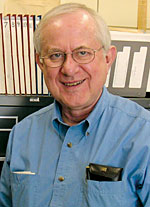John Richard Clem
DOI: 10.1063/PT.3.2252
Condensed-matter physicist John Richard Clem, renowned for his work on superconductor phenomenology, passed away on 2 August 2013 in Ames, Iowa, after a four-year battle with mesothelioma.
John was born on 24 April 1938 in Waukegan, Illinois, into a family of schoolteachers. He received scholarships to the University of Illinois at Urbana-Champaign, where he completed his BS in 1960 and his MS in 1962, both in engineering physics. Although he would later choose theoretical physics, he was most fascinated by the theories and models that lead to measurable and, better yet, practical results.

John Richard Clem

John earned his PhD under John Bardeen in 1965. The topic of his thesis, “Effects of anisotropy of the superconducting energy gap,” was suggested by Leo Kadanoff. John recalled the working atmosphere in Illinois as stimulating and exciting because of the “stellar” quality of Bardeen’s group. Bardeen was at the time a very busy man—among his other responsibilities was advising the federal government—so John was used to thinking independently and choosing problems to his liking. And his liking was mostly in what we now call the “phenomenology of superconductors,” in particular, their behavior in electromagnetic fields. That broad field became John’s lifelong passion and resulted in several seminal achievements.
After postdoctoral appointments at the University of Maryland and the Technical University of Munich, John joined the Iowa State University department of physics and astronomy and the Ames Laboratory in 1967. There he enjoyed 46 years of collaboration with colleagues. For the community of people dealing with a broad field of type II superconductivity, John’s name will always be associated with “pancake vortices,” the term he coined to describe Abrikosov vortices in layered high-Tc cuprate superconductors.
One of us (Huebener) met John for the first time in 1968 at the 11th International Conference on Low Temperature Physics in St. Andrews, Scotland; the encounter resulted in their long, intensive collaboration on the intermediate state in type I superconductors and other aspects of superconductivity. During one of Huebener’s visits to see John in Ames, they worked out a detailed exposition of low-temperature scanning electron microscopy applied to superconductors. John introduced the thermal skin effect, which was subsequently confirmed experimentally. The pinning and the motion of magnetic flux in superconductors remained his central subjects; his theoretical guidelines helped in our understanding of many experimental results.
John’s belief that scientific information must be freely available to all resulted in his establishing the tremendously popular and useful High-Tc Update, for which he was the editor from 1987 to 2000; he received hundreds of preprints and selected a few worth noting in each issue’s “Nota Bene” section. When one of us (Prozorov) was an undergraduate student in Chernogolovka, outside of Moscow, in 1989–93, before the internet or email, those two-page printed leaflets were the most anticipated mail each month. To be mentioned in John’s “Nota Bene” was considered by the superconductivity community as prestigious as having a paper published in a journal of good standing.
Among John’s many other contributions to superconducting phenomenology were his work on AC losses, edge pinning, flux cutting, and critical currents in superconducting thin-film strips of various shapes—currently a hot topic in superconducting electronics. He spent long hours analyzing data related to the intermediate state in type I superconductors, despite the fact that he was already retired and struggling with cancer. John ultimately produced an elegant solution to the problem of patterns in type I superconductors. That work became the last that he submitted for publication; it was published after his death in Physics Review B (volume 88, page 104504
Besides physics, John was interested in people, culture, and languages, and he spoke fluent German. He was also an avid vocalist. As in everything else, in music he set high standards for himself. He took lessons to keep his voice in the best shape. He enjoyed singing baritone in churches, at concerts of Musica Antiqua—an early music ensemble at Iowa State—and at conference banquets. That part of John’s life was in harmony with his love for theoretical physics—both aspire to beauty.
John’s incredible willpower showed when it turned out his mesothelioma was not curable. In fact, the intensity of his work in physics increased, despite his undergoing chemotherapy and taking care of his wife, Judy, who a few years earlier had become paralyzed after having a brain tumor removed. It was heartbreaking to watch, but John’s shining and stoic behavior will always be a moral standard for those who knew him.
More about the Authors
Vladimir Kogan. Ames Laboratory, Iowa State University, Ames.
Ruslan Prozorov. Ames Laboratory, Iowa State University, Ames.
Rudolf Huebener. University of Tübingen, Tübingen, Germany.
